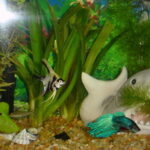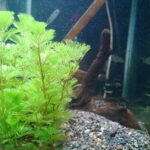When caring for freshwater fish PH and ammonia levels should be tested regularly in order to maintain a healthy environment for your fish. If the PH or ammonia balances are wrong it could mean death for your fish and you could even experience problems acclimating new fish to your aquarium. Testing the water in your aquairum is the most important thing you can do for your freshwater fish. Monitoring the PH and ammonia will not only help you detect problems that could be deadly for your fish but will help stop them before they even start.
Most freshwater fish prefer a PH around 7.0 and ammmonia levels should not exceed 1-2 parts per million (ppm). Testing the water in your aquarium is easy. Most pet stores sell both PH and ammonia test kits that are relatively cheap and simple to use. Along with your purchase of the testing kits you should also pick up some PH up and PH down solution. These solutions both come in either powder or liquid form and will need to be added to the aquarium should you need to adjust the PH levels. You have to test the quality of the water to know for sure if it is healthy for your fish. Just because it looks and smells clean does not mean it is healthy for your fish to live in.
The PH of water measures the amount of hydrogen molecules in the water. By testing the PH you will find out how acidic or alkaline the water is. More hydrogen will equal a higher PH and lower hydrogen levels produce a low PH. PH levels are different in all sources of water from your aquarium to what comes out of the tap. Water that has a lot of minerals, like water from a spring will tend to have a very high PH. Meanwhile, water that comes out of the faucet may have a very low PH because it does not have the same organic materials due to filtering. Most people fill their aquarium from the sink and at best the PH is around 4.0 which is not the right level for many fresh water fish. Before adding fish to your tank, or if you are having problems test the PH of the water. Use the PH testing kit you bough from the pet store and follow the instuctions on the package. All kits require that you take a clean vial of water from your aquarium and add a few drops of PH testing solution, and then cap and shake to get results. Most come with instructions either on or in the box, follow them closely to get correct results. Compare the color of the vial to the colors on the chart supplied with your testing kit.
When testing the water don’t use your finger to cover the top of the vial. Use the cap supplied with the testing kit. There could be foreign matter or germs on your fingertip that may influence the results of the test. You should take 2-3 tests to make sure you have accurate results. If you are having trouble getting an accurate reading for the PH take a clean container of water to your local pet store, preferably in glass. Often they will test the water and give you the results free of charge. You can also seek assistance from your pet store by asking them to correct a PH situation in your tank if you are not comfortable doing it yourself. If they cannot fix the situation for you ask them to refer you to someone that can. There are plenty of people and companies that make housecalls to clean tanks and restore the proper levels for aquariums.
If the PH is too high or too low you will need to adjust the level. Over just a few weeks the PH in your tank can naturally drop from 7.0 to a 5.0 or lower. This is part of the reason why it is so important to test the PH weekly. If the PH gets too high or too low it can be fatal for your fish. You will also have problems acclimating new fish to the aquarium if the PH is not just right. Although most fresh water fish prefer a PH of 7.0 some species like African Cichlids can go higher. Check with your pet store or vetrinarian to find out what the proper PH is for your species of fish. Most fish are sensitive to environment changes so you have to adjust the PH level slowly. Over time the fish can become accustomed to PH levels in the tank, even if they are not correct and it can kill your fish if you adjust the PH too quickly.
When adjusting the PH it is best to follow the instructions on the package. Use the PH up or PH down solution you purchased at the pet store by only adding a few drops at a time. Wait about 1 hour and then re-test the PH of the water again. Sometimes it is hard to tell how much of the solution you will need unless you’ve done it many times. Just take your time and don’t rush the process. It can take up to 48 hours to get the PH back to normal. When you have determined the PH in your aquarium is correct for the fish in it you are ready to begin the ammonia test. Do not complete the ammonia test if the PH is not at the correct levels. PH problems can lead to ammonia levels being too high so adjust the PH first.
The filter on your fish tank should be powerful enough to filter and clean the water in the tank. Proper maintenance of your filter will help keep the biological environment intact helping to filter and rid the aquarium of excess ammonia. Ammonia comes from fish urine which is mostly expelled from the gills and feces. The amount of ammonia in the water will determine whether your fish live or die. If something should go wrong with your filter you will know immediately by testing the ammonia levels. Testing the ammonia is the same process as testing the PH levels but there are now two solutions involved. As before, you should take 2-3 ammonia tests to insure you are working with accurate results. For most freshwater fish the ammonia level should never be above 2 ppm. If you notice the water in your tank is becoming cloudly or murky it’s most likely the ammonia levels are too high and the filter may be having operational problems.
The water in your aquarium can become toxic for your fish if the ammonia levels are out of whack. Follow the instructions on the testing kit and determine your results in the same manner as before. If the ammonia is too high check to make sure that the filter is working properly. You may need to replace some of the pieces like the charcoal or earth that filters the water. In more serious cases you may need to change the filter or move the fish into a larger tank. As fish grow larger they excrete more waste which in turn creates and abundance of ammonia. A tank or filter that is too small for your fish or amount of fish could spell trouble. Switching to a larger tank may help fix your ammonia problem. 1-2 ppm of ammonia is about average for a freshwater aquarium.
If you are still having problems getting the ammonia levels correct, even after following the advice above you may want to call a specialist or your pet store. If there is no ammonia in your tank, or a very low level do not worry. An aquarium that has no ammonia is actually a healthy environment. That means the filter and biological enviroment are working together to get rid of amounts of ammonia in the water and are doing it efficiently. If something goes wrong with the filter or PH balance the ammonia levels will rise rapidly. You need to monitor the levels weekly to ensure your fish are living in a healthy environment for maximum happiness.





